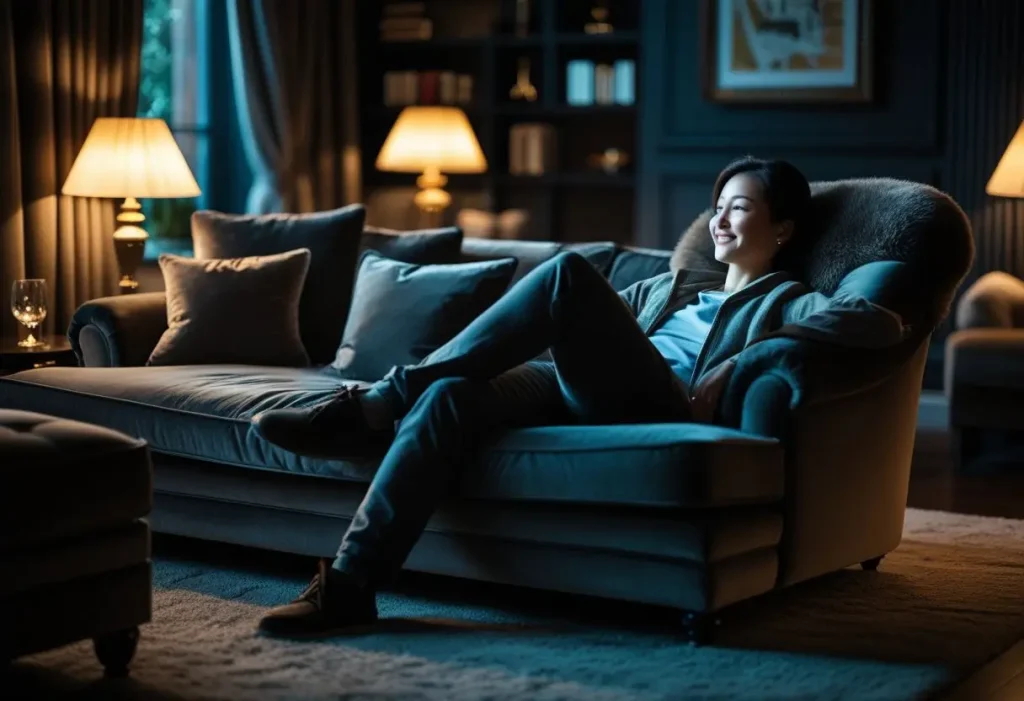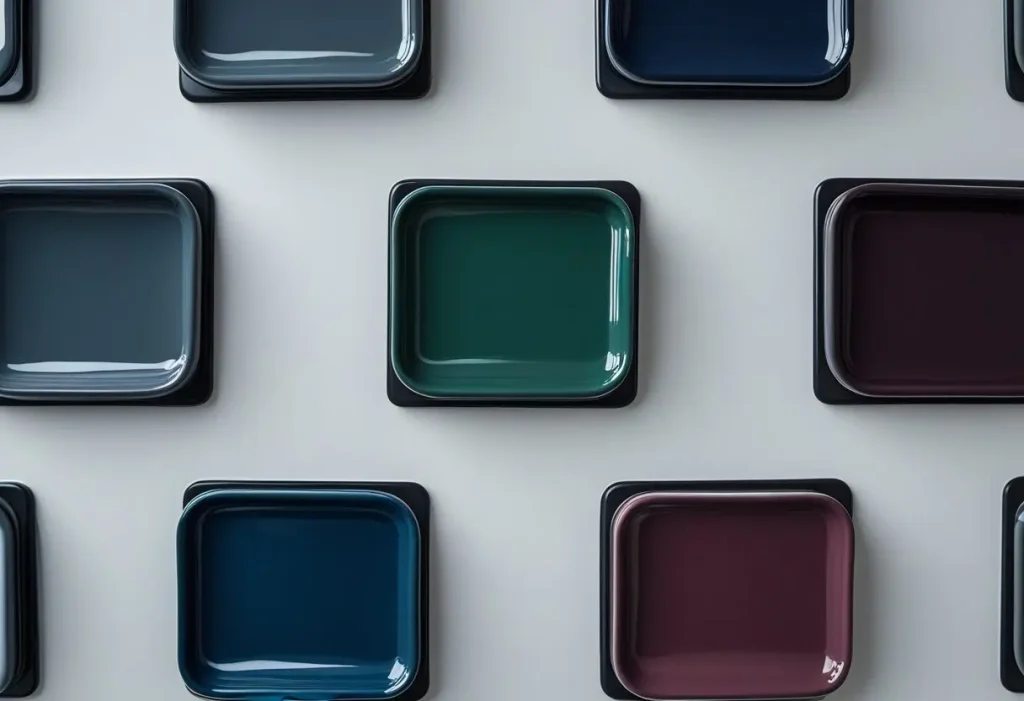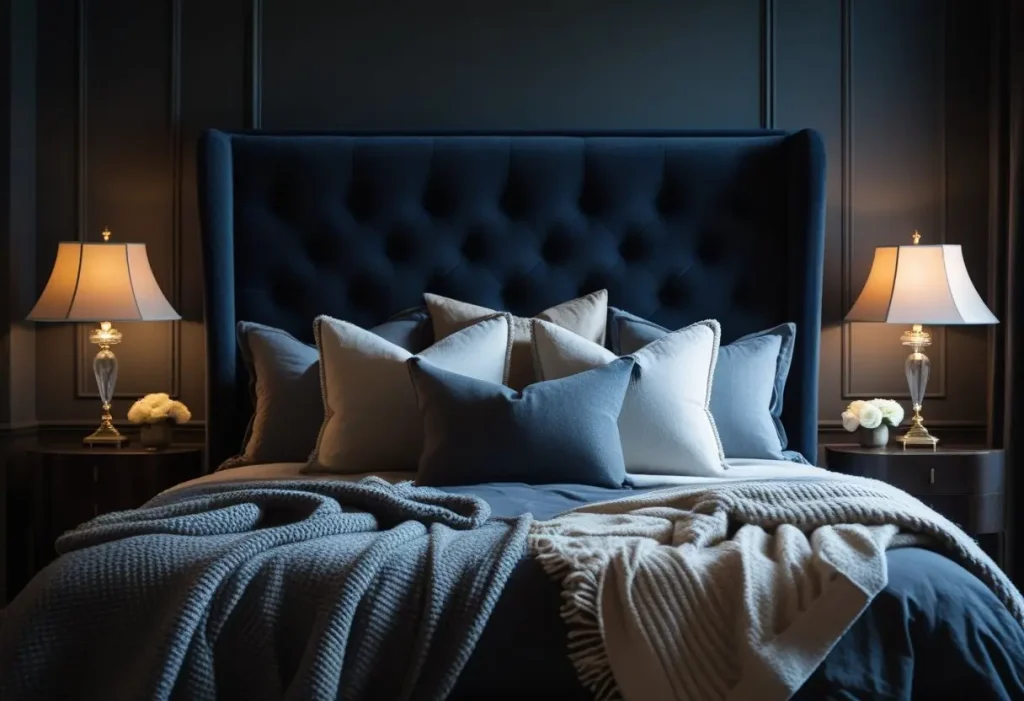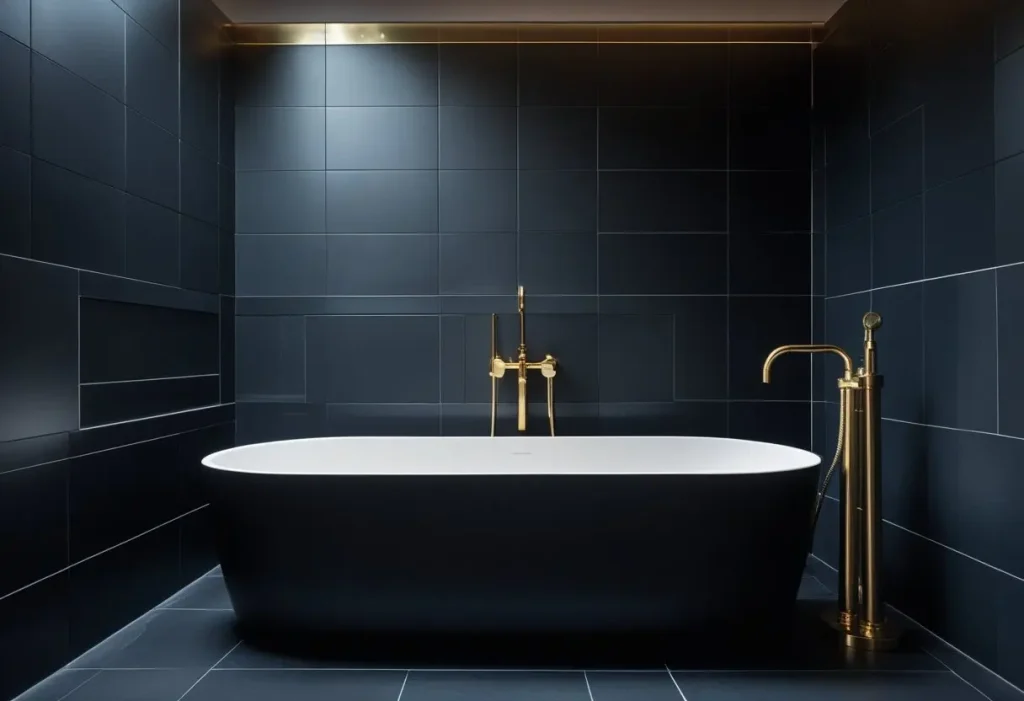In the world of interior design, a profound and elegant shift is taking place. The era of all-white, sterile minimalism is gracefully making room for a more dramatic, intimate, and personality-rich aesthetic: dark home decor. Far from being gloomy or oppressive, a well-executed dark color palette can transform your home into a haven of sophistication, warmth, and unparalleled comfort. If you’re ready to move beyond the conventional and craft a space that feels both timeless and contemporary, you’ve come to the right place.
Welcome to CozyNestDecor.pro, your premier destination for inspiring interior design ideas. This ultimate guide will demystify the art of dark home decor, providing you with actionable tips, stunning inspiration, and professional advice to help you confidently embrace the dark side. We’ll explore everything from color psychology and lighting strategies to room-by-room breakdowns, ensuring your journey into moody interiors is a resounding success. Let’s dive in and discover how to make your home not just stylish, but soulfully yours.

Table of Contents
- Why Choose Dark Home Decor? The Psychology of a Moody Palette
- The Allure of Drama and Intimacy
- Perceived Spaciousness and Depth
- A Foundation for Luxury and Warmth
- Essential Elements of Successful Dark Home Decor
- Mastering the Color Palette: Beyond Basic Black
- The Critical Role of Texture and Material
- Lighting as a Design Tool: Creating Layers of Light
- Room-by-Room Guide to Dark Home Decor
- Dark Bedroom Decor: Your Personal Retreat for Rest
- Moody Living Room Ideas: The Heart of Social Elegance
- Dark Kitchen Ideas: Culinary Spaces with Edge and Sophistication
- Dramatic Bathrooms: A Spa-Like Oasis
- Home Office & Studies: Boosting Focus with Refined Style
- Overcoming Challenges: Dark Home Decor in Small Spaces and Rental Homes
- Strategic Accent Walls and Color Blocking
- The Magic of Mirrors and Reflective Surfaces
- Tenant-Friendly Solutions for a Moody Aesthetic
- FAQs About Dark Home Decor
- What is dark home decor style?
- How do you make a room look cozy with dark decor?
- Is dark home decor good for small spaces?
- What colors go well with dark home decor?
- How can lighting improve dark home interiors?
- Is dark decor suitable for modern minimalist homes?
- What are the best dark home decor ideas for bedrooms?
- How do I balance dark walls with furniture?
- Conclusion: Embrace the Darkness with Confidence
1. Why Choose Dark Home Decor? The Psychology of a Moody Palette
Choosing to paint your walls a deep charcoal, navy, or forest green is more than just a color choice; it’s a design statement with profound psychological impact. Understanding the “why” behind this trend is the first step to implementing it successfully.
The Allure of Drama and Intimacy
Dark home decor inherently creates a sense of drama and gravitas. Deep hues absorb light, carving out space and defining forms in a way that light colors cannot. This creates visual interest and a dynamic environment that feels curated and intentional. More importantly, these spaces foster intimacy. A dark living room or bedroom naturally feels more enclosed and protected, like a cozy cocoon. To explore more cozy home styling tips, check out our Cozy Home Decor Ideas guide for inspiration.
This is the antithesis of open-plan, brightly lit spaces, offering a sanctuary where you can unwind and feel truly secluded from the outside world. For those seeking a luxury dark interior, this intimate atmosphere is synonymous with exclusive, high-end hotels and private members’ clubs.
Perceived Spaciousness and Depth
A common misconception is that dark colors make a room feel smaller. In reality, they can often create an illusion of depth and mystery. Because dark colors recede, they can blur the boundaries of a room, making it difficult to discern where the walls end and the ceiling begins. This can, paradoxically, make a room feel larger and more expansive.
When you can’t immediately see the corners of a room, your imagination fills in the blanks, creating a sense of infinite space. This technique is a hallmark of sophisticated modern dark home decor.
A Foundation for Luxury and Warmth
Dark walls act as a perfect, rich backdrop that makes other elements pop. Artwork, textiles, and furniture stand out with greater intensity against a dark canvas. This allows your cherished possessions to take center stage.
Furthermore, dark colors have a unique ability to feel incredibly warm. Deep burgundies, chocolates, and terracottas are naturally warm, but even cooler tones like navy and charcoal can feel warm when paired with the right materials, such as rich woods, brass accents, and soft, textured fabrics. This combination is the secret to achieving cozy dark spaces that are far from cold or uninviting.
2. Essential Elements of Successful Dark Home Decor
To avoid the pitfalls of a poorly executed dark room, you must master three core elements: color, texture, and light. Getting this triad right is the difference between a dungeon and a divine retreat.
Mastering the Color Palette: Beyond Basic Black
While black is a powerful anchor, the world of dark home decor is vast and varied. The key is to choose a hue that resonates with the room’s purpose and the feeling you want to evoke.
- Charcoal and Deep Grey: The most versatile choice. Perfect for a modern minimalist home, grey provides a neutral, sophisticated base that works with any accent color.
- Navy Blue: Evokes a sense of calm and stability. Excellent for bedrooms and studies. Pair with crisp white and gold for a nautical-meets-luxury feel.
- Forest Green and Hunter Green: Brings the tranquility of nature indoors. Ideal for creating a relaxing, library-like atmosphere in living rooms and studies. It pairs beautifully with natural wood and leather.
- Burgundy and Oxblood: Adds a dose of opulence and drama. Perfect for dining rooms or accent walls in a bedroom, creating a sense of intimacy and passion.
- Dark Teal and Navy Green: A contemporary and rich choice that feels both classic and current. Wonderful for adding color without being overly vibrant.

The Critical Role of Texture and Material
In a light room, color and pattern often drive the design. In a dark room, texture is king. Without varied textures, a dark space can fall flat. The goal is to create a tactile experience that catches the light in different ways.
- Fabrics: Incorporate velvet (for ultimate luxury), chunky knits (for coziness), linen (for a relaxed feel), and silk (for subtle sheen).
- Woods: Use rich, grainy woods like walnut, oak, or teak. The natural grain adds visual rhythm and warmth.
- Metals: Warm metals like brass, copper, and gold are perfect for luxury dark interior designs. They provide brilliant contrast and a touch of glamour. Matte black metals can enhance a monochromatic scheme.
- Natural Elements: Stone, marble, and terracotta bring organic texture and prevent the space from feeling too manicured.
- Wall Treatments: Consider textured wallpaper, such as grasscloth or anaglypta, or even wood paneling (wainscoting or shiplap painted in a dark hue) to add depth to your walls.
Lighting as a Design Tool: Creating Layers of Light
This is the most crucial element. A single overhead light in a dark room is a recipe for disaster. Instead, think in layers:
- Ambient Lighting: This is the general illumination. Avoid harsh ceiling lights. Opt for dimmable fixtures or use multiple low-level light sources. Cove lighting or wall washers can softly bounce light off the ceiling, creating a gentle glow.
- Task Lighting: This is functional light for specific activities. A reading lamp by an armchair, a pendant light over a kitchen island, or a desk lamp. These pools of light create focus and interest.
- Accent Lighting: This is the decorative layer that adds sparkle and highlights features. Use picture lights to illuminate artwork, LED strips to highlight shelves, or a series of small candles to create a magical ambiance. This layer is essential for making your dark home decor feel dynamic and inviting.
For more inspiration on lighting techniques, authoritative resources like Architectural Digest’s lighting guides can be invaluable.
3. Room-by-Room Guide to Dark Home Decor
Let’s apply these principles to specific rooms in your home, offering tailored dark home decor ideas for each space.
Dark Bedroom Decor: Your Personal Retreat for Rest
The bedroom is the ideal candidate for a dark scheme. The goal is to create a calming, cave-like environment conducive to sleep and relaxation.
- Color Scheme: Opt for soothing tones like deep blue, charcoal, or a muted plum. These colors promote a sense of peace and security.
- Textiles: Invest in a luxurious bed. Use multiple layers of pillows and throws in different textures—velvet, cashmere, linen. A thick, plush rug underfoot is essential.
- Lighting: Use bedside table lamps with warm-toned bulbs on dimmer switches. Wall sconces free up surface space and provide elegant, directed light.
- Furniture: Choose wooden furniture in warm tones to contrast with the walls. A statement upholstered headboard in a contrasting color or texture can serve as a fantastic focal point.

Moody Living Room Ideas: The Heart of Social Elegance
A dark living room should feel both inviting for guests and cozy for family nights in. It’s the perfect setting for a moody living room that encourages conversation and relaxation.
- Color Scheme: Don’t be afraid to go bold. Dark green or navy can make a living room feel incredibly rich and welcoming. If painting all walls feels too daring, start with a single accent wall behind the sofa or television.
- Furniture Balance: Balance dark walls with a mid-tone or light-colored sofa to prevent the room from feeling too heavy. Alternatively, embrace the drama with a dark sofa but ensure it’s a different texture or shade than the walls.
- Accents: Use metallic accents in lamps, picture frames, and coffee table decor. Add life with greenery; plants pop beautifully against dark walls. Artwork with light mats will draw the eye.
- Cozy Factors: A large, soft area rug is non-negotiable. Layer in personal items like books and objects collected from travels to make the space feel lived-in and loved.
Discover more ideas for creating a cohesive look in our guide to [Insert link to cozy nest blog category on living room decor].
Dark Kitchen Ideas: Culinary Spaces with Edge and Sophistication
Dark kitchen ideas are trending for a reason. They feel grounded, sleek, and hide wear-and-tear beautifully.
- Cabinetry: Dark blue, black, or charcoal cabinets are a powerful statement. Pair them with a stunning countertop like white marble, light quartz, or even wood to create a strong contrast.
- Backsplash: This is your opportunity to introduce texture and light. A subway tile in a glossy finish, patterned cement tiles, or a metallic backsplash will reflect light around the room.
- Hardware: This is the jewelry of the kitchen. Brass or copper handles and taps will add a luxurious sparkle against dark cabinetry.
- Lighting: Under-cabinet lighting is critical for providing task light on countertops. Statement pendant lights over the island will serve as both a task and ambient light source.
For professional kitchen design insights, resources like Houzz’s kitchen photo gallery are excellent.
Dramatic Bathrooms: A Spa-Like Oasis
Transform your bathroom into a personal spa with a dark, moody palette.
- Walls and Tiles: Use dark, large-format tiles to create a seamless, expansive look. Matte finishes are particularly luxurious. Consider a dark, freestanding bathtub as a centerpiece.
- Vanity: A dark wood or painted vanity adds substance. Pair with a striking stone or composite sink top.
- Fixtures: Contrast is key. Choose polished chrome or brass fixtures for a stunning look against dark surfaces.
- Accessories: Plush, dark towels, a teak bath mat, and a single orchid can elevate the space to a five-star hotel level.

4. Overcoming Challenges: Dark Home Decor in Small Spaces and Rental Homes
You don’t need a vast, period home to enjoy the benefits of dark home decor. With smart strategies, you can incorporate this trend anywhere.
Strategic Accent Walls and Color Blocking
Instead of painting an entire small room dark, choose one wall to highlight. This draws the eye and creates depth without overwhelming the space. Color blocking—painting geometric sections of a wall in different dark shades—is a modern way to add drama and artistic flair.
The Magic of Mirrors and Reflective Surfaces
Mirrors are a small space’s best friend, and they are doubly powerful in a dark room. A large mirror opposite a window will maximize natural light. Reflective surfaces like glossy paint, metallic decor, and glass tables will help bounce light around the room, preventing it from being absorbed.
Tenant-Friendly Solutions for a Moody Aesthetic
If you’re renting, you can still achieve the look.
- Wallpaper: Use temporary, peel-and-stick wallpaper in a dark pattern on a single wall.
- Furniture and Textiles: Invest in a large, dark bookcase, a dark sofa, or a dramatic area rug. These elements define the space’s color scheme without touching the walls.
- Art and Accessories: Create a gallery wall with large, dark-framed art. Use dark throws, cushions, and curtains to envelop the room in a moody palette.
5. FAQs About Dark Home Decor
Q1: What is dark home decor style?
Dark home decor is an interior design style that utilizes deep, rich color palettes—such as charcoal, navy, forest green, and black—as the primary foundation for a room. Contrary to the misconception of being gloomy, this style aims to create spaces that are intimate, sophisticated, and cozy.
It relies heavily on strategic lighting, varied textures (like velvet, wood, and metal), and thoughtful contrasts to build a layered and inviting atmosphere. Ranging from modern dark home decor with minimalist lines to opulent luxury dark interior schemes or even gothic home decor with ornate details, this style is versatile and focuses on crafting a powerful emotional impact and a sense of sanctuary within the home.
Q2: How do you make a room look cozy with dark decor?
The key to achieving cozy dark spaces lies in balancing the dark palette with warmth and texture. First, ensure your lighting is layered and warm; use dimmable lamps, sconces, and candles instead of a single bright overhead light. Second, incorporate a plethora of soft textiles—a plush wool rug, a chunky knit throw, velvet cushions, and heavy curtains add tactile comfort that makes a room feel inviting. Finally, introduce natural elements like wood furniture and live plants, which bring organic warmth and life. The combination of these elements transforms a dark room from a simple color choice into a snug, enveloping retreat.
Q3: Is dark home decor good for small spaces?
Absolutely. When executed correctly, dark home decor can be remarkably effective in small spaces. Dark colors can recede, blurring the corners of a room and creating an illusion of depth that makes the space feel larger than it is. The trick is to embrace the coziness rather than fight it. Use a monochromatic scheme to create a seamless look, incorporate large mirrors to reflect light and views, and ensure you have adequate, layered lighting to avoid dark shadows. Painting built-in shelves or alcoves a dark color can make them disappear, making the room feel more open. It’s a bold strategy that can yield a incredibly stylish and intimate result.
Q4: What colors go well with dark home decor?
Dark walls serve as a perfect backdrop for a wide range of accent colors. For a classic and crisp look, white and cream are unbeatable, providing sharp contrast. Warm metallics like brass, gold, and copper add instant glamour and luxury. For a earthy, organic feel, pair dark walls with terracotta, mustard yellow, or blush pink. If you prefer a cohesive, tonal scheme, use different shades of the same color family (e.g., charcoal walls with lighter grey furniture). For a bold, contemporary statement, vibrant colors like emerald green or sapphire blue can create a dazzling effect against a dark base.
Q5: How can lighting improve dark home interiors?
Lighting is the most critical component in a dark room. Poor lighting can make it feel cave-like, while excellent lighting makes it feel magical. The goal is to create a “pool of light” effect. Avoid relying on one central ceiling light. Instead, use a combination of ambient lighting (dimmable overheads or uplighters), task lighting (floor lamps for reading, under-cabinet lights in kitchens), and accent lighting (picture lights, candles, LED strips). This layered approach ensures the room is functionally lit where needed, while also creating a warm, dynamic ambiance with areas of shadow that add to the drama and coziness of the dark home decor.
Q6: Is dark decor suitable for modern minimalist homes?
Yes, dark home decor and modern minimalism are a perfect match. The minimalist philosophy of “less is more” is amplified by a dark palette, which naturally simplifies a space by reducing visual noise. In a modern dark home decor scheme, clean lines, uncluttered surfaces, and functional furniture are highlighted against the deep backdrop. The focus shifts to the form and texture of a few well-chosen pieces rather than on many decorative items. A dark, monochromatic color scheme can make a minimalist room feel more grounded, intentional, and sophisticated than an all-white scheme, which can sometimes feel sterile.
Q7: What are the best dark home decor ideas for bedrooms?
The best dark bedroom decor ideas focus on creating a restful sanctuary. Start by painting the walls a soothing deep tone like navy, charcoal, or a muted green. Choose a luxurious upholstered headboard in a contrasting texture or color to serve as a focal point. Layer your bed with high-quality bedding in various textures—linen sheets, a velvet throw, wool blankets. Incorporate warm, dimmable lighting through bedside sconces or table lamps. Finally, add a soft, large area rug and some personal art with light frames to complete the serene and cozy atmosphere, making your bedroom the perfect place to unwind.
Q8: How do I balance dark walls with furniture?
Balancing dark walls with furniture is essential to prevent a room from feeling too heavy. You have two main approaches. The first is contrast: pair dark walls with light-colored furniture (e.g., a light grey or tan sofa, light wood tables) to make the furniture pop and keep the room feeling airy. The second is tonal layering: if you prefer a more immersive look, choose furniture that is a slightly different shade or texture than the walls. For example, pair charcoal walls with a black leather sofa and walnut wood tables. The variation in material (matte wall vs. glossy leather vs. grainy wood) creates depth and interest without relying on light-dark contrast.
6. Conclusion: Embrace the Darkness with Confidence
Dark home decor is not merely a passing trend; it is a powerful and timeless design choice that celebrates depth, emotion, and sophistication. By understanding the principles of color, texture, and, most importantly, light, you can transform any room in your home into a deeply personal, cozy, and luxurious sanctuary. It’s about creating a space that feels uniquely yours—a place that offers comfort, inspires conversation, and provides a peaceful retreat from the outside world.
We hope this comprehensive guide has illuminated the path for your own dark home decor journey. Remember, the goal is not to create a perfect magazine spread, but a home that reflects your personality and makes you feel truly at ease. Don’t be afraid to experiment, start small if you need to, and most importantly, have fun crafting your own cozy nest.
For more inspiration and detailed guides on bringing these ideas to life, explore our other articles on [Insert link to cozy nest blog category on color psychology] and [Insert link to cozy nest blog category on lighting design].